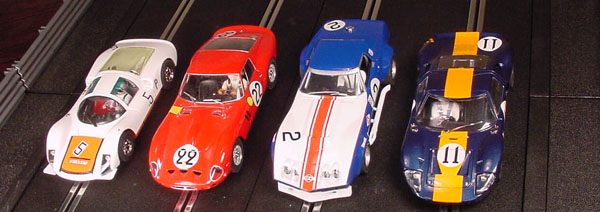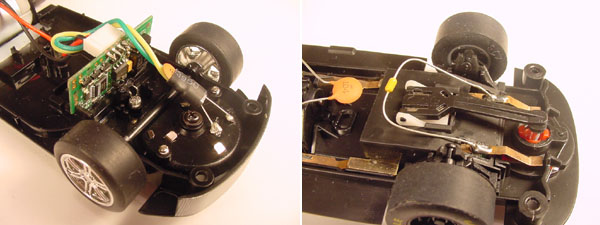1 24 Slot Cars Advantages
Slot car racing has been around sine the 1950s in its original form, the "conventional" or "analog" version in which each car runs in its own lane. Now, however, the new digital version, in which cars can change lanes to overtake and pass, is a rapidly growing part of the hobby. As a result, there are more choices than ever for the beginning racer. Which is best for you or for that person you are buying a race set as a gift for? Here is some information that will help you decide.
In conventional slot car racing each car races in a single lane, and the number of cars that can be raced at one time equals the number of lanes. Most home racing layouts have 2 or 4 lanes, though up to 8 lanes are possible if you have the space. Each driver races in only one lane, but the race can be divided into heats with the drivers switching lanes between heats to give each driver equal time on each lane. This cancels out any differences between lanes for all the drivers.

Four conventional 1/32 scale slot cars line up to race on a 4-lane track.
Digital, the newest form of model car racing, allows as many as 6 cars, or in some cases 8, to race on a 2-lane track. Electronic circuitry in the cars and controllers allows each driver to have full control over his own car. Any or all of the cars can be racing in either lane at any given time, and lane change track sections placed at various locations around the circuit allow drivers to change lanes to overtake and pass or to take the fastest line for an entire lap.

Two SCX digital NASCARs race nose to tail while a third changes lanes to pass.
Which of the two you choose depends on a number of factors that will be different for each person. Here is a guide to help you sort them out:
Space is the first factor to take into account. Because you can have multiple drivers on only a two-lane track a digital layout can be more compact for the same number of drivers. This can be very helpful if you have only a small space in which to build your layout.
Cost is another. Digital race sets and cars are more expensive than conventional ones because of the cost of the electronics involved. If you adapt cars from various manufacturers to run on your digital track you have to install the required digital chip in each one. This can cost up to $20 per car. However, because you only need a 2-lane track to accommodate 4 or 6 cars and drivers you don't need to buy as much track as you would need to build a 4 or 6-lane conventional track. This issue can go either way depending on how big a layout and how many cars you want to have. If you want a long, challenging layout but don't need or want many different cars you may well come out ahead with a digital system. If you want to own and race many different cars from many manufacturers the cost of the digital chips adds up and may make conventional racing more cost-effective.
Complexity also comes into play. Conventional racing is simpler, as the driver only needs to control the car's speed and doesn't have to concern himself with making lane changes. Most people can pick up digital driving fairly readily, but small children, who have a way to go in developing coordination and attention span, may find conventional racing easier to master and less frustrating, resulting in a more successful initial experience with the hobby. Conventional cars and controllers are also simpler and more maintainable with fewer things that can go wrong and no need for cars to be programmed before running them. In general, however, digital systems have proven to have quite adequate reliability.
There is no theoretical limit to the size and lap length of either a conventional or a digital layout. However, in either case you need additional wiring to ensure uniform distribution of power to all parts of a circuit once the lap length rises above 30 feet or so. You can add additional power taps to your layout with snap-on wiring sets made by the race set manufacturers, so dealing with this issue is not difficult. Most digital tracks have another problem to consider, however. As lap length increases you will usually add more lane change sections. Both the cars and the lane-change gates are powered by a single power supply. Once you get above 4 or 5 lane change sections there will be a need for a track power upgrade providing more amperage to keep the electrical needs of the lane change gates from affecting the performance of the cars. An alternative is to rewire the system to power the lane change gates separately from the cars. This takes some skill and equipment for soldering. Cost-wise this is probably not much different from adding a larger power supply or powering each lane separately on a multi-lane conventional layout, a very common practice.

The digital chip module in a Scalextric (L.) and in an SCX car. The type of lane change activation, electric or mechanical, dictates the size, configuration, and constraints on the location of the module.
One manufacturer, SCX, powers its lane changers mechanically rather than electrically. This takes the number of lane change tracks in your layout entirely out of the power equation. This is great, but it's bought at a price. The mechanical lane changers require each car to have a bulky activator located immediately aft of the guide post, between the car's front wheels. This makes it difficult, and in many cases impossible to convert other manufacturers' cars to the SCX system simply because of the space requirements inside the car. You can adapt almost any slot car to any digital system with enough skill, equipment, cost, and effort, but as a practical matter many users will be restricted to running only SCX cars on their SCX digital layout.
Scalextric, Ninco, and Carrera use the same track system for both conventional and digital racing, so you can readily convert your layout from one kind of operation to the other by removing all the special track sections and other components related to digital operation and replacing them with those needed for conventional racing, or vice-versa. The digital cars will run on a conventional track, though they may not have dynamic braking. With Scalextric, especially, cars are easy to convert from conventional to digital by installing the necessary digital chip. In some cases this is an entirely plug-and-play operation. This allows you to start with a simpler, lower-cost conventional system and transition at relatively moderate cost to digital later on. You can also convert a digital track to conventional if you find that digital racing is unsuitable for any reason. SCX, however, uses two entirely different track systems. Its digital track system has many good features, but converting from SCX conventional to digital or vice-versa means starting over from scratch.
One major drawback to digital racing, at least at present, is that none of the available digital systems are compatible with each other. You can't run one manufacturer's digital car on another's digital track without converting it to the other manufacturer's system by swapping the chip modules. This will require electrical soldering and often requires modifications to the car's chassis, also. If you want to own and race a large number of cars from a wide range of manufacturers on a digital track you will be faced with the need to install the appropriate digital chip in each car at about $20 per installation. By contrast, any 1:32 scale RTR car will run on any manufacturer's conventional track and power system with, at most, some minor trimming of the guide flag to adapt to a shallower slot. Cars may not always achieve optimum performance with another manufacturer's power supply and controllers but they will run reasonably well. And, of course, cars from the many manufacturers who don't make sets and track will run on any of the conventional track systems.
Both conventional and digital cars can be equipped with different tires, traction magnets, and even motors to increase their performance. Motor and magnet hopups cause the car to draw more amperage from the track and often require the track to be equipped with a higher-amperage power supply or separate power to each lane as well as aftermarket controllers with resistance values (or their solid-state equivalent) better suited to the needs of the cars. With a conventional system power upgrades are easy, often plug-and-play. Connection tracks, or power bases, often come with sockets for plugging in a power supply for each lane. A variety of high-quality aftermarket controllers that plug directly into the various manufacturers' connection tracks is readily available for conventional systems. So far, however, there are no aftermarket upgrade controllers for digital systems, though that will undoubtedly change before long.
With digital systems the power demands of modified cars run up against the power demands of multiple lane change gates to make power system upgrades, especially the separate powering of the lane changers, even more necessary. None of the stock power systems that come with digital race sets will go very far with either before needing to be upgraded. Modified cars require power upgrades on conventional tracks, too, but most people who are not engaged in all-out organized competition can add plenty of performance to their cars without needing to go beyond a simple plug-and-play installation of one standard power supply per lane. On this last point you'll get vehement disagreement from some posters on slot car bulletin boards. However, our long-term experience demonstrates that for most slot car hobbyists it's more important to equalize their cars at a performance (and cost) level and set of driving characteristics they enjoy than to take every car to the outer limits of the performance envelope. This great majority of home slot car racers simply doesn't need extreme power upgrades.
These are the basic issues that affect your choice between conventional and digital slot car racing. Both are great fun and each has its advantages and disadvantages. You may very well want further advice or information after reading this, and we invite you to call us at 310-858-8540. We'll be glad to have one of our technical experts give you all the help you need in making the best choice for you.
Article Clarification:
In our last newsletter we published an article which included this statement: "Both conventional and digital cars can be equipped with different tires, traction magnets, and even motors to increase their performance." This is true but requires some clarification. Digital chips are limited in their ability to handle the increased current requirements of cars with high-performance motors and very strong magnets. At some point a digital car modified in these ways will pull enough current through the chip to cause its failure. Other kinds of performance upgrades, such as a change of gear ratio or the use of aftermarket tires of the same diameter as the car's original tires, do not significantly affect current draw and therefore can be done safely. In many cases there is room for some level of motor or magnet upgrade to a digital car before chip failure happens, but purchasers of digital systems should understand that modifying digital cars for increased performance voids all warranties and is, therefore, done entirely at their own risk.
If you have a question or comment on this article please send it to support@electricdreams.com.
Source: https://www.electricdreams.com/conventional-or-digital-which-is-best-for-you/

0 Response to "1 24 Slot Cars Advantages"
Post a Comment